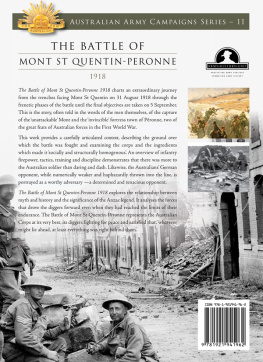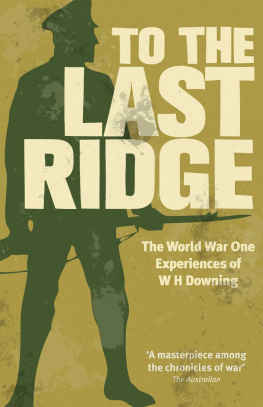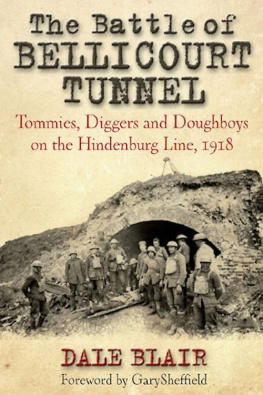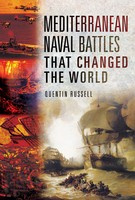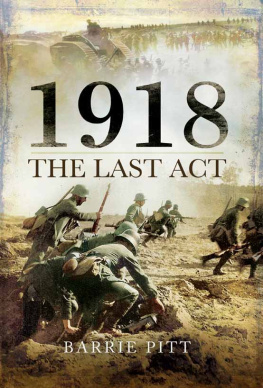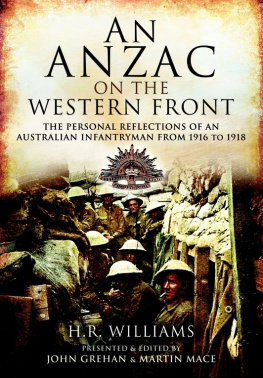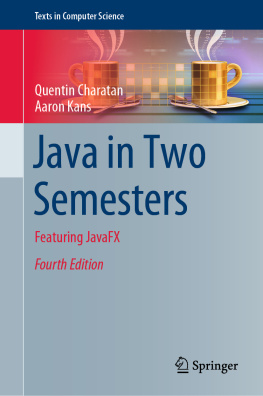
AUSTRALIAN ARMY CAMPAIGNS SERIES - 11
THE BATTLE OF
MONT ST
QUENTIN-PERONNE
1918

MICHELE BOMFORD

Copyright Army History Unit
Campbell Park Offices (CP2-5-166)
Canberra ACT 2600
AUSTRALIA
(02) 6266 4248
(02) 6266 4044 - fax
Copyright 2012 Commonwealth of Australia
First published 2012
This book is copyright. Apart from any fair dealing for the purposes of private study, research, criticism or review as permitted under the Copyright Act, no part may be reproduced, stored in a retrieval system or transmitted in any form or by any means, electronic, mechanical, photocopying, recording or otherwise, without written permission.
All inquiries should be made to the publishers.
Big Sky Publishing Pty Ltd
PO Box 303, Newport, NSW 2106, Australia
Phone: 1300 364 611
Fax: (61 2) 9918 2396
Email:
Web: www.bigskypublishing.com.au
National Library of Australia Cataloguing-in-Publication entry (pbk)
Author: Bomford, Michele.
Title: The battle of Mont St Quentin-Pronne 1918 / Michele Bomford.
ISBN: 9781921941962 (pbk.)
Notes: Includes bibliographical references and index.
Subjects: Somme, 2nd Battle of the, France, 1918.
Australians--Warfare--France--Somme.
World War, 1914-1918--Participation, Australian.
Somme (France)--History, Military.
Dewey Number: 940.435
Cover design and typesetting by Think Productions, Melbourne
Front cover and title page: Men from the 24th Battalion in Elsa Trench just minutes before the attack on Mont St Quentin at 1.30 pm, 1 September 1918. Photo probably taken by Hubert Wilkins. (AWM E03142)
Back cover: A 54th Battalion post in Pronne, 2 September 1918. The destruction of the town is clearly visible.
This iconic photograph was probably taken by Hubert Wilkins. (AWM E03183)
The Capture of Mont St Quentin by Fred Leist, showing men of the 20th Battalion and German soldiers in a trench on the flank of Mont St Quentin. (AWM ART02929)
Men of the 4th Field Artillery Brigade having lunch beside their camouflaged gun sited in an open position, 2 September 1918. (AWM E03145)
CONTENTS
In 2004 the then Chief of Army Advisory Group, comprising the Armys senior generals, established a scheme to promote the study and understanding of military history in the Army. The Campaign Series was established from this decision, with its focus on Armys future leaders. The series complements Armys other history publications, which produce academically rigorous and referenced analytical works.
The Campaign Series focuses on leadership, command, strategy, tactics, lessons and personal experiences of war. Each title within the series includes extensive visual information maps, including specifically prepared maps in colour and 3D, commissioned artwork, photographs and computer graphics.
The Campaign Series covers both the well known campaigns and battles and those that are less well known. The Australian Army History Unit sees this series growing into a significant contribution to the history of the Australian Army, one that will provide an excellent introduction to the campaigns and battles the Army has fought.
Roger Lee, Army Historian
When Denny Neave from Big Sky Publishing suggested I write this book for the Campaigns Series to follow my other book on the Battle of Mont St Quentin-Pronne, Beaten Down By Blood, I was taken completely by surprise, but welcomed the challenge and the opportunity. Denny, Roger Lee and the team from the Australian Army History Unit particularly Dr Andrew Richardson who coordinated the photographs have supported me throughout what has been a lengthy process. The Australian Army History Unit also assisted me with a grant in 2009 which enabled me to undertake my field work in France in 2010.
Eric Olasons cartographic skills, Kim Gardners typesetting and design, Diane Evans proofing and the artwork of Mark Wahlert and Jeff Isaacs have particularly enhanced the book. Cathy McCullaghs expert editing has also been very much appreciated.
The ongoing support of Dr Peter Stanley (Director of the Centre for Historical Research, National Museum of Australia), Brigadier Chris Roberts, AM, CSC (Retd) and Major General Paul Stevens (Retd), has been invaluable. Many of their insights into the Battle of Mont St Quentin-Pronne have found their way into these pages. John Littler (Deputy Director, Projects, Office of Australian War Graves, Department of Veterans Affairs) provided most of the material on the Australian Remembrance Trail and developments relating to the Mont St Quentin site which form part of the Epilogue. I am grateful for his interest and ready response to my questions. The mayor of Pronne, Mme Valerie Kumm, gave permission for use of photographs from the Muse Alfred-Danicourts collection, while the museums director, David de Sousa, made these available.
My husband, Stephen Bomford, read a draft of the manuscript and offered some valuable suggestions. His patience and forbearance allowed me to work solidly in order to meet my deadlines and he was a wonderful sounding block for many of my ideas.
To the many others too numerous to name here who have contributed to the Mont St Quentin-Pronne project since its inception four years ago, I offer my heartfelt thanks.
For almost 100 years Australians have defined their nations role in the First World War in terms of the disastrous Gallipoli campaign of 1915. Only recently has there been a growing awareness that Australian troops also fought on the Western Front the main theatre of war in France and Belgium as part of the British Expeditionary Force (BEF) which, from December 1915, was under the command of General (later Field Marshal) Sir Douglas Haig. Names such as Fromelles, Pozires, Bullecourt and Passchendaele all battles fought in 1916 and 1917 and which led to huge casualties for little tactical gain have slowly begun to seep into the Australian consciousness, overlaid with images of mud and blood and the appalling conditions of trench warfare.
Yet, in 1918, the nature of war on the Western Front changed. With the failure of the German offensives from March to August, the Allies could launch their own counter-offensive to push their opponents back. The stalemate was broken and movement, such as had not been seen since 1914, returned to the battlefield. Australian formations, now grouped together as the Australian Corps and, from the end of May, led by Lieutenant General Sir John Monash, were involved in a string of military victories which helped to end the war later that year.
It is time Australians understood more about the battles of 1918. Recognition of the achievements of the men who fought in these battles is long overdue; likewise they have long been denied their place in the national memory and historiography of the Great War. These were not just battles characterised by the courage, determination, bravery and dash which typify the Anzac legend, although those elements were there in abundance; these were battles of skill, tactics and discipline which reflected the training and experience of a corps which was at the peak of its fighting effectiveness.
The Battle of Mont St Quentin-Pronne, fought in late August and early September 1918, was almost entirely an Australian operation. Unlike Monashs other operations, this was not a set-piece battle devised after days or perhaps weeks of meticulous planning and which utilised every available mechanical resource then available to the Allies on the Western Front. Indeed Chris Roberts has described Mont St Quentin-Pronne as a fluid battle, characterised by the freewheeling manoeuvre of large formations and a series of quick attacks. These features set it apart from other battles.
Next page
